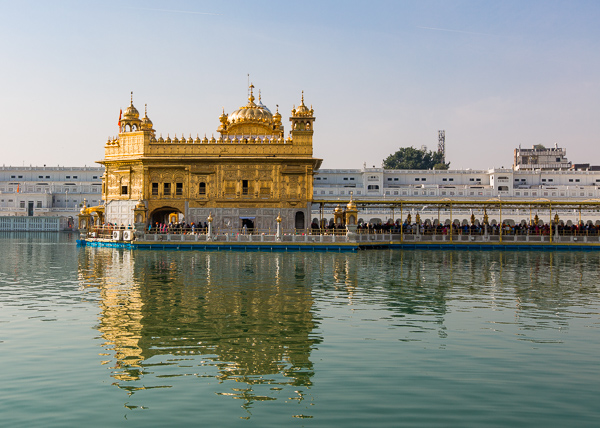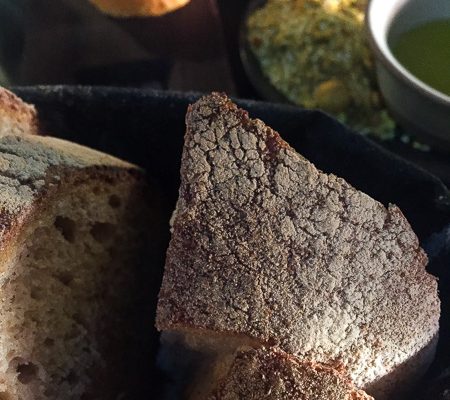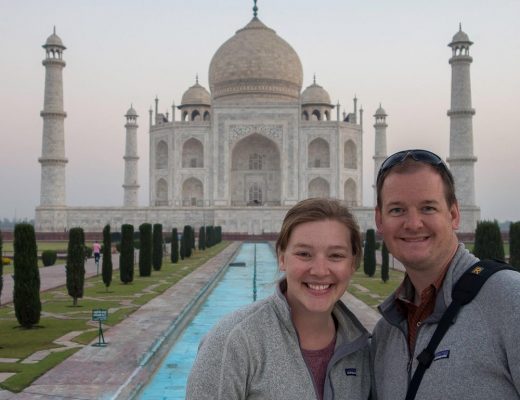Equality. It’s the word that came up repeatedly yesterday during our tour of the Golden Temple in Amritsar, India; the holiest place on earth for the 28 million people of the Sikh faith. Up until yesterday we were wholly ignorant about this religion, which is young (founded in 1469) compared to the other major religions such as Hinduism (founded in 15th century BC), Judaism (founded in 9th century BC), Buddhism (founded in 6th century BC), Christianity (founded in 1st century AD), and Islam (founded in 7th century AD).
A Brief History of Sikhism
The Sikh religion (pronounced “sick”) was actually created in India by a man raised in a Hindu family. Disenfranchised by some of the major tenants of the Hindu religion, mainly the caste system, he set out to create a faith with a foundation in equality. It’s a focus which has permeated every facet of the faith. For example, the Golden Temple has four entrances, one on each side, to symbolize that people from everywhere are welcome. The cornerstone of the temple was actually laid by a Muslim man t0 demonstrate every faith is welcomed as well. This appears again in their holy book, the Guru Granth Sahib, where many of the teachings and writings are from people of other faiths.
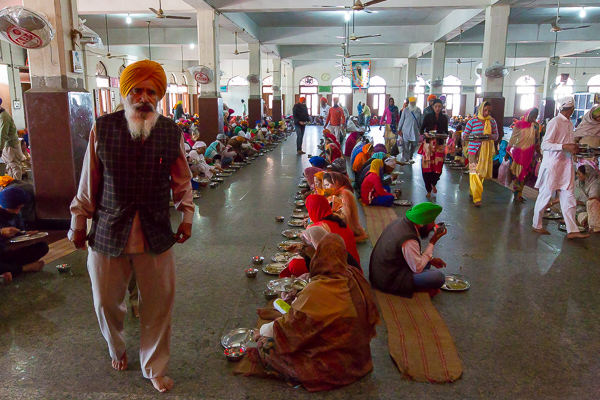
Another staple of the Sikh faith includes providing meals to everyone for free, but unlike other faiths which do this, the Sikh seem to take it a step further. It isn’t only people who are in need that eat here. Instead, people in suits and ties are sitting on the floor next to the homeless as they are all given the same food. That same diverse population is also volunteering to make the food, serve it, and clean up. The Golden Temple alone serves more than 100,000 people each day round the clock.
“Who are we to say that we are superior and you are inferior, or who are you to say that you are superior and I am inferior? We are all human beings,” said Anil, our guide explaining what the Sikh believe. The reason for the Sikh’s reverence for the Golden Temple is twofold. First, their holy book resides at the temple. Second, several of the human gurus blessed the location of the Golden Temple while they were alive. There were 10 human holy gurus, each selected by the previous guru, starting with the first, Guru Nanak, the creator of Sikhism. When it came time for the 10th guru to choose his successor, he instead appointed the Guru Granth Sahib, the holy book, as the everlasting guru.
The Golden Temple, the Spiritual Center of the Sikh Faith
Interestingly, the Guru Granth Sahib is treated in some ways like a human. Each day the book is brought from the Akal Takht, a building near the temple and the political center of the Sikh faith, to the Golden Temple. Each night the book is put to bed, literally. The reason for this is they believe the guru needs to rest in order to continue to deliver its message with potency each day.
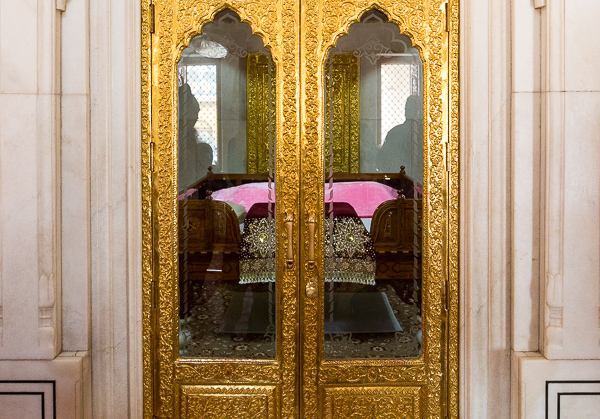
This is the bed where the Guru rests each night after being ferried from the Golden Temple atop a beautifully decorated palanquin.
More than 100,000 people pay their respect to the Guru Granth Sahib each day, so we joined the long queue to enter the temple to do so as well. We were surrounded by men, women, and children all dressed in colorful clothing. Men of the Sikh faith wear colorful turbans, which added to the festiveness felt in the temple. Photography and talking are not allowed in the queue or in the temple, but it was far from quiet as we waited nearly an hour to enter. Staring at about 4:30 a.m. when the book is delivered to the temple and continuing until the book is put to bed, performers sing passages from the scripture accompanied by instruments. While not everyone sings along for each part, I will never forget when a certain passage was started and the entire crowd joined in. I still get goosebumps just thinking about it.
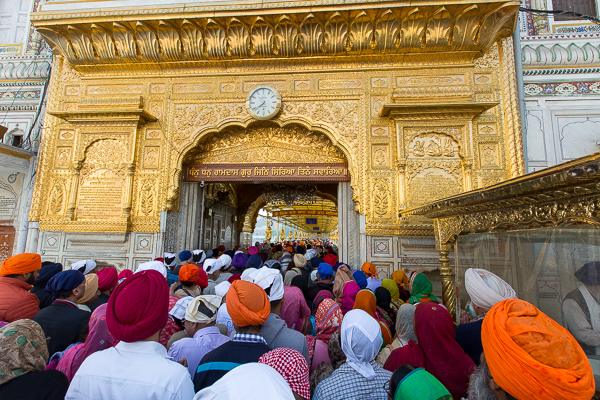
The queue to enter the Golden Temple is long but relatively peaceful, providing time for meditation and prayer.
As we got closer to the temple entrance, more and more people got down on their hands and knees to bow and pray. When we reached the doors of the temple, people touched the door sill as a sign of respect before stepping over it into the temple. The temple itself was a relatively small room packed with people. Metal barriers created a square in the center of the room where the book was, although you couldn’t see it because it was draped in cloth. People were on their hands and knees praying while tossing money, or beautiful textiles into the partitioned area. The textiles were draped over the holy book and the money was collected. The three musicians sat to the right of the holy book singing into microphones which were broadcasting throughout the temple complex.
After leaving the room where the book rested, we went upstairs to the second level of the temple. We learned throughout the Golden Temple there are more than 100 copies of the holy book being constantly read. Teams of people read for 45-minute intervals, in order to read the entire book in 48 hours. This is called Akhand Path which translates into never-ending prayer. When someone in your family gets married or passes away, you pay a large amount of money to dedicate a reading to them. Currently, the waitlist for readings is more than four years long.
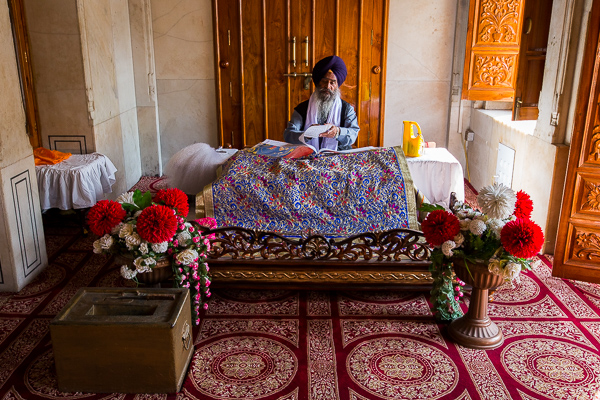
One of the many examples of Akhand Path we saw throughout the Golden Temple.
After leaving the temple, we were given a sweet offering made of wheat, sugar, ghee – a butter-like substance, and water.
Akal Takht, the Political Center of the Sikh Faith
Then, we went to the Akal Takht building, which serves as the political center of the Sikh faith. In this building, we saw the bed where the Guru Granth Sahib is laid to rest each night, and we also saw the swords of the gurus. Sprinkled throughout the building were more readers completing the Akhand Path.
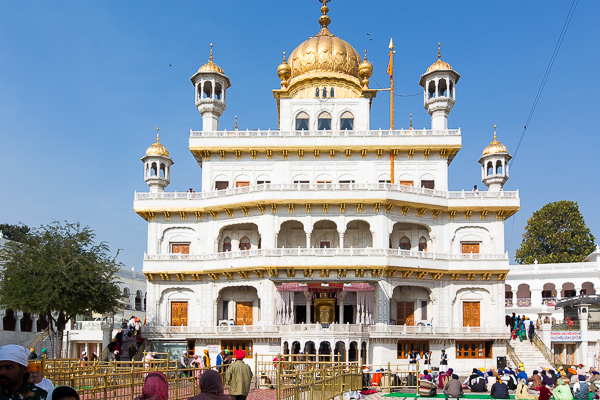
The Akhal Takht or the political seat of power for the Sikh faith.
As we took the staircase up to the roof of Akal Takht, we found a handful of volunteers dusty from the construction they were doing. Several of them came over and asked to get a photo with us and we happily obliged. After the photo was taken, we had a long conversation about Sikhism with them through our guide who translated. They also asked us questions about what we thought of the Sikh faith. One fascinating thing we learned from the Sikh volunteers was the “five k’s”, or Panj Kakaar; a staple of the Sikh religion, and five things all baptized Sikhs are required to wear.
- Kesh – Sikh’s aren’t allowed to cut their hair and are required to wear a dastar or turban.
- Kanga – A wooden comb, hidden under the turban of all the men we spoke too.
- Kachera – A specific type of cotton underwear which looks sort of like boxers.
- Kara – An iron bracelet.
- Kirpan – An iron dagger, with a curved end.
We’ve been to a lot of places of worship in our travels, but while sometimes those places can feel uncomfortable, we felt nothing but welcomed at the Golden Temple. It was an incredible and spiritual place where we learned a lot about a religion and culture we didn’t know anything about.
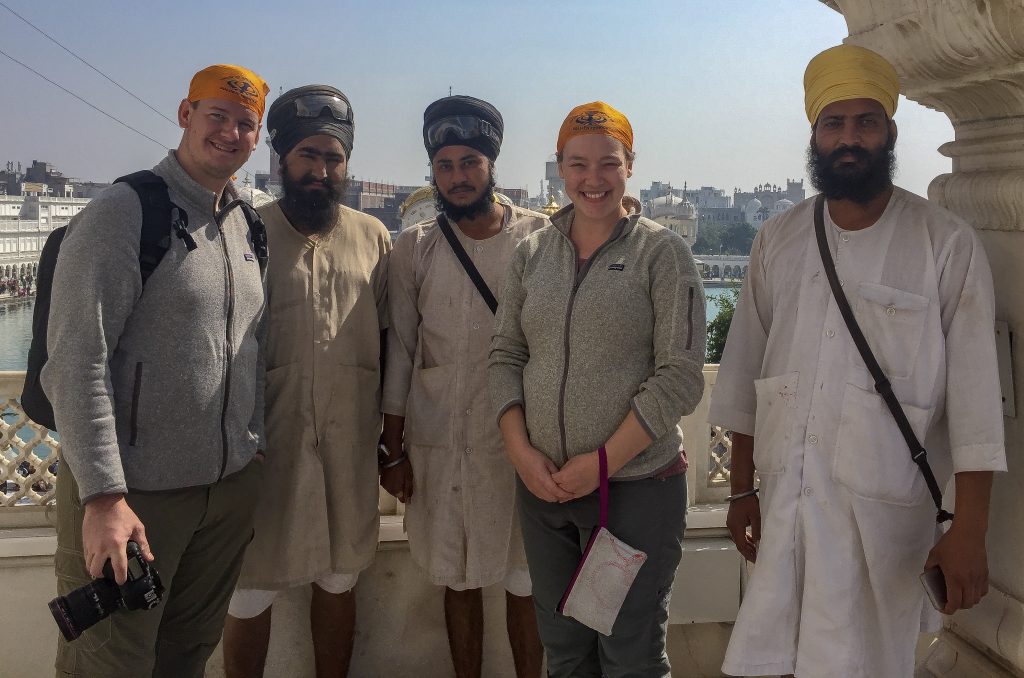
A few of the Sikh volunteers we spoke to.
Other Interesting Things We Learned:
- Sikhs are monotheistic, believing in Ik Onkar, or One Supreme Reality.
- Of the 28 million Sikhs in the world, 20 million live in India, twelve million in the Punjab state of India. The other eight million live across the world with the largest population of Sikh outside India living in the United States, Canada, and England.
- Justin Trudeau, the Canadian Prime Minister is going to visit the Golden Temple tomorrow. We saw his staff doing security checks while we were there yesterday.
- The Golden Temple was given its name because the temple is covered in actual plates of gold.
- The Golden Temple is surrounded by a man-made Sarovar or pool built by the fifth guru. The name translates to pool of nectar of immortality.
- The Dukh Bhanjani Ber Tree, which provides some shade to the pool around the Golden Temple has a special story. It is believed, if you take a dip in the pool beneath the tree you can be cured of your ailments.
- Amritsar, the city home to the Golden Temple, was started by the fourth guru.
- The Guru Granth Sahib, holy book, is written in the Gurmukhī alphabet, a script made by the second guru using Laṇḍā scripts, another language found in Northern India. Since many people don’t speak that language, it is also offered in Punjabi and English.
